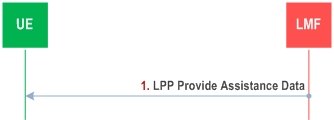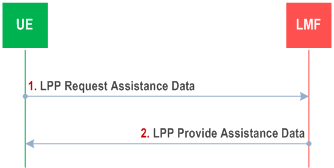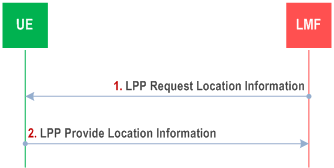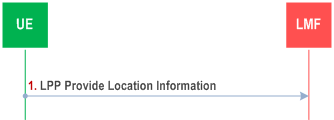Content for TS 38.305 Word version: 18.1.0
1…
4…
5…
6…
6.5…
6.7…
7…
7.3A…
7.4…
7.6…
7.11…
7.12…
8…
8.1.2.1a…
8.1.3…
8.2…
8.3…
8.4…
8.5…
8.6…
8.7…
8.8…
8.9…
8.10…
8.11…
8.12…
8.13…
8.14…
8.15…
A…
8.7 TBS positioning
8.7.1 General
8.7.2 Information to be transferred between NG-RAN/5GC Elements
8.7.2.0 General
8.7.2.1 Information that may be transferred from the LMF to UE
8.7.2.1.0 General
8.7.2.1.1 Acquisition Assistance
8.7.2.1.2 Almanac
8.7.2.2 Information that may be transferred from the UE to LMF
8.7.2.2.0 General
8.7.2.2.1 Standalone mode
8.7.2.2.2 UE-assisted mode
8.7.2.2.3 UE-based mode
8.7.3 TBS Positioning Procedures
8.7.3.1 Capability Transfer Procedure
8.7.3.2 Assistance Data Transfer Procedure
8.7.3.2.0 General
8.7.3.2.1 LMF initiated Assistance Data Delivery
8.7.3.2.2 UE initiated Assistance Data Transfer
8.7.3.3 Location Information Transfer Procedure
8.7.3.3.0 General
8.7.3.3.1 LMF initiated Location Information Transfer Procedure
8.7.3.3.2 UE-initiated Location Information Delivery Procedure
...
...
8.7 TBS positioning p. 115
8.7.1 General p. 115
Terrestrial Beacon Systems (TBS) is the standard generic term for a network of ground-based transmitters broadcasting signals for geo-spatial positioning with wide-area or regional coverage. The following TBSs are supported in this version of the specification:
- Metropolitan Beacon Systems (MBS).
- UE-Assisted: The UE performs TBS measurements with or without assistance from the network, and sends these measurements to the LMF where the position calculation takes place, possibly using additional measurements from other (non-TBS) sources;
- UE-Based: The UE performs TBS measurements and calculates its own location, possibly using additional measurements from other (non-TBS) sources.
- Standalone: The UE performs TBS measurements and calculates its own location, possibly using additional measurements from other (non-TBS) sources, without network assistance.
8.7.2 Information to be transferred between NG-RAN/5GC Elements p. 116
8.7.2.0 General |R18| p. 116
This clause defines the information that may be transferred between LMF and UE.
8.7.2.1 Information that may be transferred from the LMF to UE p. 116
8.7.2.1.0 General |R18| p. 116
Table 8.7.2.1.0-1 lists assistance data for both UE-assisted and UE-based modes that may be sent from the LMF to the UE.
| Assistance Data |
|---|
| Acquisition assistance |
| Almanac |
8.7.2.1.1 Acquisition Assistance p. 116
Acquisition assistance provides the MBS receiver with information about visible beacons, PN Codes, and other information of the MBS signals to enable a fast acquisition of the MBS signals.
8.7.2.1.2 Almanac p. 116
Almanac assistance provides the MBS receiver with MBS beacon parameters that can be used to determine the UE position.
8.7.2.2 Information that may be transferred from the UE to LMF p. 116
8.7.2.2.0 General |R18| p. 116
The information that may be signalled from the UE to the LMF is summarized in Table 8.7.2.2.0-1.
| Information | UE-assisted | UE-based / Standalone |
|---|---|---|
| UE position estimate with uncertainty shape | No | Yes |
| Timestamp | Yes | Yes |
| Indication of used positioning methods in the fix | No | Yes |
| TBS measurements (code phase (MBS)) | Yes | No |
| Measurement quality parameters for each measurement | Yes | No |
8.7.2.2.1 Standalone mode p. 116
In Standalone mode, the UE reports the latitude, longitude and possibly altitude, together with an estimate of the location uncertainty, if available.
The UE should also report an indication that TBS method is used and possibly other positioning methods used to calculate the fix.
8.7.2.2.2 UE-assisted mode p. 117
In UE-assisted mode, the UE reports the TBS associated measurements, together with associated quality estimates. These measurements enable the LMF to calculate the location of the UE, possibly using other measurements and data.
8.7.2.2.3 UE-based mode p. 117
In UE-based mode, the UE reports the latitude and longitude, together with an estimate of the location uncertainty, if available.
The UE should also report an indication that TBS method is used and possibly other positioning methods used to calculate the fix.
8.7.3 TBS Positioning Procedures p. 117
8.7.3.1 Capability Transfer Procedure p. 117
The Capability Transfer procedure for TBS positioning is described in clause 7.1.2.1.
8.7.3.2 Assistance Data Transfer Procedure p. 117
8.7.3.2.0 General |R18| p. 117
The purpose of this procedure is to enable the LMF to provide assistance data to the UE (e.g., as part of a positioning procedure) and the UE to request assistance data from the LMF (e.g., as part of a positioning procedure).
8.7.3.2.1 LMF initiated Assistance Data Delivery p. 117
Figure 8.7.3.2.1-1 shows the Assistance Data Delivery operations for the network-assisted TBS method when the procedure is initiated by the LMF.

Step 1.
The LMF determines that assistance data needs to be provided to the UE (e.g., as part of a positioning procedure) and sends an LPP Provide Assistance Data message to the UE. This message may include any of the TBS assistance data defined in clause 8.7.2.1.
8.7.3.2.2 UE initiated Assistance Data Transfer p. 117
Figure 8.7.3.2.2-1 shows the Assistance Data Transfer operations for the network-assisted TBS method when the procedure is initiated by the UE.

Step 1.
The UE determines that certain TBS assistance data is desired (e.g., when the LMF provided assistance data are not sufficient for the UE to fulfil the request) and sends a LPP Request Assistance Data message to the LMF. This request includes an indication of which specific TBS assistance data is requested.
Step 2.
The LMF provides the requested assistance data in a LPP Provide Assistance Data message, if available at the LMF. The entire set of assistance data may be delivered in one or several LPP messages. In this case, this step may be repeated by the LMF several times. If any of the UE requested assistance data in step (1) are not provided in step 2, the UE shall assume that the requested assistance data are not supported, or currently not available at the LMF. If none of the UE requested assistance data in step (1) can be provided by the LMF, return any information that can be provided in an LPP message of type Provide Assistance Data which includes a cause indication for the not provided assistance data.
8.7.3.3 Location Information Transfer Procedure p. 118
8.7.3.3.0 General |R18| p. 118
The purpose of this procedure is to enable the LMF to request position measurements or location estimate from the UE, or to enable the UE to provide location measurements to the LMF for position calculation.
8.7.3.3.1 LMF initiated Location Information Transfer Procedure p. 118
Figure 8.7.3.3.1-1 shows the Location Information Transfer operations for the TBS method when the procedure is initiated by the LMF.

Step 1.
The LMF sends a LPP Request Location Information message to the UE for invocation of TBS positioning. This request includes positioning instructions such as the positioning mode (UE-assisted, UE-based, Standalone), specific requested UE measurements if any, and quality of service parameters (accuracy, response time).
Step 2.
The UE performs the requested measurements and possibly calculates its own location. The UE sends an LPP Provide Location Information message to the LMF before the Response Time provided in step (1) elapsed. If the UE is unable to perform the requested measurements, or if the Response Time provided in step 1 elapsed before any of the requested measurements have been obtained, the UE returns any information that can be provided in an LPP message of type Provide Location Information which includes a cause indication for the not provided location information.
8.7.3.3.2 UE-initiated Location Information Delivery Procedure p. 119
Figure 8.7.3.3.2-1 shows the Location Information delivery operations for the TBS method when the procedure is initiated by the UE.

Step 1.
The UE sends an LPP Provide Location Information message to the LMF. The Provide Location Information message may include UE TBS measurements or location estimate already available at the UE.